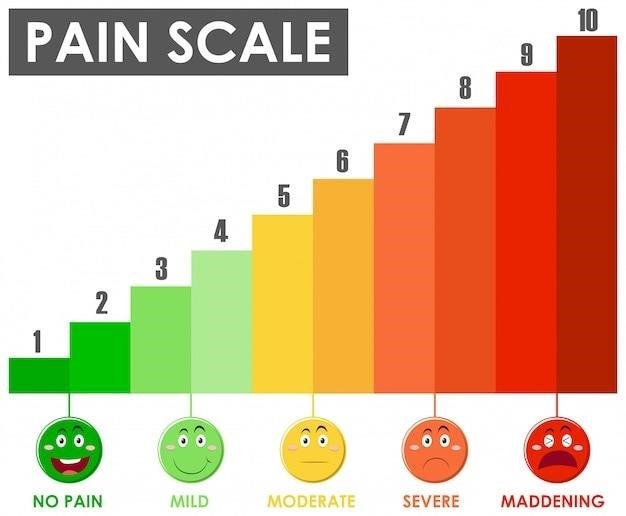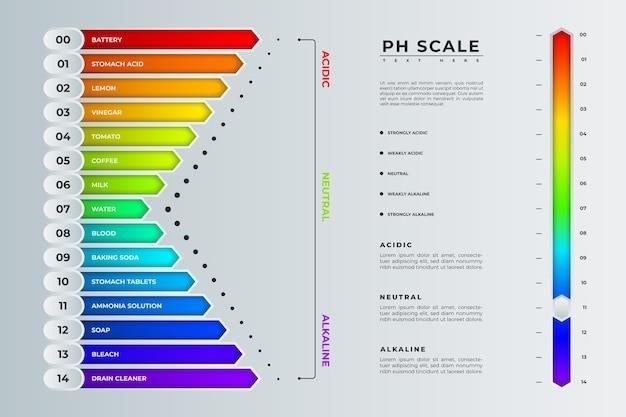The Visual Analog Scale (VAS)⁚ A Powerful Tool for Assessing Pain
The Visual Analog Scale (VAS) is a simple and widely used tool for measuring the intensity of subjective experiences, most commonly pain. It consists of a straight line, usually 10 centimeters long, with anchors at each end representing the extremes of the experience being measured, such as “no pain” and “worst pain imaginable.” Patients are asked to mark a point on the line that corresponds to their current level of pain. The VAS is a valuable tool for assessing pain in various clinical settings and research studies.
What is a VAS?
The Visual Analog Scale (VAS) is a measurement instrument designed to quantify subjective experiences that are difficult to measure directly, such as pain, fatigue, or mood. It typically involves a straight line, usually 10 centimeters long, with endpoints representing the extremes of the experience being measured. For example, a pain VAS might have “no pain” at one end and “worst pain imaginable” at the other. Patients are asked to mark a point on the line that corresponds to their current level of the experience. The distance from the “no pain” end to the marked point provides a numerical score representing the intensity of the experience.

The VAS is a popular tool in healthcare due to its simplicity and ease of use. It is often used in conjunction with other pain assessment tools, such as the Numeric Rating Scale (NRS) or the McGill Pain Questionnaire. The VAS is also widely used in research studies to measure the effectiveness of pain management interventions or to assess the impact of various treatments on pain levels. It is a versatile tool that can be adapted to assess a variety of subjective experiences, making it a valuable instrument in clinical practice and research.
How is a VAS Used?
The VAS is typically presented to the patient as a horizontal line, often printed on paper or displayed on a screen. The endpoints of the line are labeled with descriptors that represent the extremes of the experience being measured. For example, for pain assessment, the endpoints might be labeled “no pain” and “worst pain imaginable.” The patient is then instructed to mark a point on the line that corresponds to their current level of pain. The distance between the “no pain” endpoint and the marked point is then measured in millimeters or centimeters, providing a numerical score that reflects the intensity of the patient’s pain.
The VAS can be used in various clinical settings, including hospitals, clinics, and research studies. It is often used as a routine assessment tool to monitor pain levels over time, evaluate the effectiveness of pain management interventions, or assess the impact of different treatments on pain perception. The VAS is a simple and straightforward tool that can be easily administered and understood by patients, making it a valuable instrument for assessing subjective experiences in a wide range of healthcare settings.
Advantages of Using a VAS
The Visual Analog Scale (VAS) offers several advantages as a tool for assessing pain and other subjective experiences. Its simplicity and ease of use are key benefits, making it accessible to patients with varying levels of literacy and cognitive abilities. The VAS requires minimal training for administration and interpretation, allowing healthcare professionals to readily incorporate it into their assessments.
Furthermore, the VAS is a highly sensitive instrument, capable of detecting even subtle changes in pain intensity. This sensitivity allows for a more nuanced understanding of a patient’s pain experience and aids in monitoring the effectiveness of pain management strategies. The VAS is also a reliable tool, demonstrating consistent results when administered repeatedly under similar conditions. This reliability ensures that changes in VAS scores are likely due to genuine variations in pain levels, rather than random fluctuations.
Another advantage of the VAS is its ability to quantify subjective experiences, converting subjective feelings into measurable data. This numerical representation of pain intensity facilitates communication between patients and healthcare professionals, promoting a shared understanding of the patient’s condition. The VAS is a valuable tool for research, allowing researchers to compare pain levels across different groups, assess the effectiveness of various treatments, and investigate the factors that influence pain perception.
Limitations of Using a VAS
While the Visual Analog Scale (VAS) offers numerous advantages, it also has limitations that should be considered. One key limitation is its subjectivity. The VAS relies entirely on the patient’s self-reported perception of pain, which can be influenced by various factors, such as mood, cultural background, and personal tolerance levels. This inherent subjectivity can lead to variations in VAS scores even when pain levels are objectively similar.
Another limitation is the difficulty in interpreting VAS scores in the context of individual patients. While the VAS provides a numerical measure of pain intensity, it doesn’t account for the complex interplay of factors that contribute to a patient’s overall pain experience. This lack of context can make it challenging to determine the clinical significance of VAS scores, particularly when comparing them across different patients or time points.
Furthermore, the VAS is a unidimensional measure, focusing solely on pain intensity. It doesn’t capture other aspects of the pain experience, such as quality, location, or duration. This limited scope can hinder a comprehensive understanding of a patient’s pain and potentially lead to inadequate management strategies. Finally, the VAS is susceptible to bias, particularly when administered by healthcare professionals who may inadvertently influence the patient’s response. This bias can be mitigated through careful training and the use of standardized administration procedures, but it remains a potential concern.

Interpreting VAS Scores
Interpreting VAS scores requires careful consideration of several factors beyond the numerical value itself. Understanding the individual patient’s baseline pain level, their typical pain fluctuations, and any relevant medical history is crucial for accurate interpretation. For instance, a score of 5 might signify severe pain for a patient who usually experiences minimal discomfort, whereas it might be considered mild for someone with chronic pain.
Changes in VAS scores over time are often more informative than single scores. A significant decrease in VAS scores following treatment suggests pain relief, while an increase may indicate a worsening of pain. However, interpreting changes requires awareness of potential confounding factors, such as natural fluctuations in pain intensity or the influence of medication.
It is essential to remember that VAS scores are a subjective measure and should be interpreted within the context of the patient’s overall clinical presentation. Factors such as verbal descriptions of pain, non-verbal cues, and functional limitations should be integrated with VAS scores to develop a comprehensive understanding of the patient’s pain experience and guide appropriate management strategies.
VAS in Different Clinical Settings
The VAS finds extensive application across various clinical settings, proving particularly valuable in pain management, rehabilitation, and research. In pain management, clinicians utilize the VAS to assess the severity of pain experienced by patients, track changes in pain levels over time, and evaluate the effectiveness of pain relief interventions. This allows for individualized treatment plans tailored to each patient’s unique pain profile.
In rehabilitation settings, the VAS aids physical therapists and occupational therapists in monitoring progress during recovery from injury or surgery. By measuring pain levels during specific exercises or activities, therapists can adjust treatment plans and ensure safe and effective rehabilitation.
Research studies frequently employ the VAS to collect quantitative data on pain perception, allowing researchers to compare different treatment approaches, assess the impact of interventions, and gain insights into the underlying mechanisms of pain. The versatility of the VAS across diverse clinical settings underscores its significance as a reliable and valuable tool for measuring pain intensity.
Examples of VAS Scales
Visual Analog Scales (VAS) can be adapted to measure a wide range of subjective experiences beyond pain. Here are some examples of VAS scales used in different clinical settings⁚
Pain VAS⁚ This is the most common type of VAS, where the scale ranges from “no pain” to “worst pain imaginable.” It is frequently used to assess pain intensity after surgery, during rehabilitation, or in chronic pain conditions.
Fatigue VAS⁚ This scale measures the severity of fatigue, with anchors like “no fatigue” and “extreme fatigue.” It is helpful in assessing fatigue related to chronic illnesses, medication side effects, or sleep disorders.
Nausea VAS⁚ This scale assesses the level of nausea experienced by patients, with anchors like “no nausea” and “worst nausea imaginable.” It is commonly used to evaluate nausea associated with chemotherapy, pregnancy, or other medical conditions.
Dyspnea VAS⁚ This scale measures the severity of shortness of breath, with anchors like “no shortness of breath” and “worst shortness of breath imaginable.” It is useful for assessing dyspnea in patients with respiratory illnesses or heart conditions.
These are just a few examples of the diverse applications of VAS scales in clinical practice. The versatility and simplicity of the VAS make it a valuable tool for measuring a wide range of subjective experiences.
Using a VAS in Research
The Visual Analog Scale (VAS) is a popular tool in research studies for several reasons⁚
Reliability and Validity⁚ VAS scales have demonstrated good reliability, meaning that they consistently produce similar results when used repeatedly. They also show evidence of validity, indicating that they measure what they are intended to measure.
Sensitivity to Change⁚ VAS scales are sensitive to changes in the measured experience, making them useful for tracking the effectiveness of interventions or treatments. Researchers can use the VAS to assess the impact of a new medication, therapy, or lifestyle change on pain levels or other subjective experiences.
Ease of Use⁚ VAS scales are simple to administer and understand, making them suitable for use with diverse populations, including those with limited literacy skills. Patients can easily mark a point on the line to indicate their experience, requiring minimal instructions.
Data Analysis⁚ VAS scores are easily quantifiable, allowing for statistical analysis of data. Researchers can use the VAS to compare groups, assess correlations between variables, and draw meaningful conclusions from the data.
In research, VAS scales are frequently used to assess pain, fatigue, nausea, dyspnea, mood, and other subjective experiences. They play a crucial role in evaluating the effectiveness of treatments, understanding the impact of medical conditions, and gaining insights into the human experience.
The Visual Analog Scale (VAS) is a valuable tool for assessing pain and other subjective experiences in both clinical and research settings. Its simplicity, ease of use, and demonstrated reliability and validity make it a widely adopted method for measuring pain intensity, particularly in situations where verbal communication is limited or difficult.
While the VAS has limitations, such as the potential for bias and the difficulty in interpreting extreme scores, it remains a robust and widely accepted tool. Understanding the strengths and limitations of the VAS is crucial for its effective application in clinical practice and research.
As technology advances, digital versions of the VAS are becoming more prevalent, offering advantages such as automated data collection and analysis. These advancements are further enhancing the VAS’s role in healthcare, allowing for more efficient and accurate assessments of pain and other subjective experiences.
The VAS continues to be a powerful tool for healthcare professionals and researchers seeking to understand and manage pain and other subjective experiences effectively.

